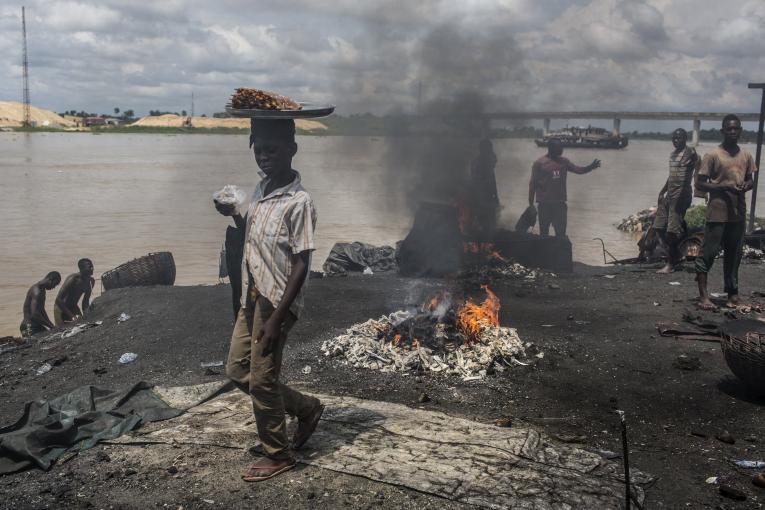Across Africa, increased motor vehicle use, industrial growth and dust storms coupled with wood-fired cooking stoves is resulting in air pollution that is choking the continent’s inhabitants.
—
While air pollution in India, China, and other emerging economies has become a major area of concern for scientists and policymakers, it has gained little traction in Africa where it is taking a serious toll on the economy and human health. Toxic air has been causing more premature deaths than unsafe water or childhood malnutrition on the continent while significantly contributing to the climate crisis.
Air Pollution in Africa: Facts
A report by UNICEF notes that deaths from outdoor air pollution in Africa have increased by 57% in less than three decades, from 164,000 in 1990 to 258,000 in 2017, resulting in a GDP loss of over $215bn annually. The pollution has also cut short the lives of children by 24 months.
A recent study from NASA states that pollution from industrial sources and motor vehicles cause high mortality rates in Nigeria and South Africa while emissions from burning biomass and poor air quality due to dust storms increase the number of premature deaths in West and Central Africa.
“Africa holds the world’s largest source of desert dust emissions and produces approximately a third of the Earth’s biomass burning aerosol particles,” the study says. “Sub‐Saharan biomass burning is driven by agricultural practices, such as burning fields and bushes in the post-harvest season for fertilisation, land management, and pest control.”
Causes of Air Pollution in Africa
Analysis of satellite imagery by Greenpeace reveals that the world’s deadliest air pollution spot on the planet is in South Africa, with its eastern province Mpumalanga being the largest single area infected by deadly nitrogen dioxide. The province is home to a dozen coal-fired power stations, processing plants, and factories, which release the gas into the atmosphere.
Emissions such as sulfur dioxide, particulate matter, and mercury have been causing more than 2,000 deaths from respiratory disease, strokes, and heart attacks in many places in South Africa, including Johannesburg.
You might also like: Air Pollution: The Silent Killer

Africa’s most populous country — Nigeria — suffers from air pollution worse than any other country on the continent. The World Health Organisation (WHO) lists four cities of Nigeria among the world’s worst-ranked cities for air quality. Onitsha — one of the country’s economic hubs — tops the list of worst-ranked cities globally with a record of 30 times more particulate matter (PM2.5) concentration in the air than the WHO’s recommended levels.
A world air quality report from Greenpeace ranks Nigeria as the 10th most polluted country in the world, with an estimated average PM2.5 concentration of 44.8 micrograms per cubic meter air (μg/m3). More than 64,000 people died from household air pollution in the country in 2017, mainly from the burning of solid fuels such as charcoal and wood for cooking in open fires and leaky stoves.
Senegal is also struggling with highly toxic air. Its capital Dakar scored an average PM2.5 level of 30 μg/m3 and a PM10 level of 146 μg/m3; that is seven times higher than WHO recommended threshold. During the dry season, dust-storm from the Sahara — harmattan — and pollution from industry and motor vehicles coalesce in a hovering toxic cloud.
Kenya’s predicament mirrors that of its neighbours, with particle concentrations that are twice the WHO health safety standards. Over 18,000 premature deaths in the country have been linked to air pollution, while respiratory diseases climbed to be Kenya’s number one killer, surpassing malaria.
The true scale of the problem is likely to be underestimated, as only seven of Africa’s 54 countries have installed functioning real-time air pollution monitors to collect the data. Population growth and rapid urbanisation are expected to further worsen conditions. With an additional 1.3 billion people set to occupy the continent by 2050, industrial, agricultural, and anthropogenic activities are likely to lower air quality. Costs associated with pollution might explode if bold policy changes are not urgently initiated by African nations.
The leaders of African nations need to resist the temptation of fossil fuel corporations seeking to exploit a country’s resources or enter their market. As urbanisation and industrialisation ramps up across Africa, policies must be put in place that prioritise renewable energy and use green technologies in urban construction. As the number of companies researching and developing such innovations continues to grow, the cost of engaging such companies and implementing new technologies falls. Policymakers should focus on partnerships and agreements with other countries to build sustainably. An international agreement that holds governments accountable for their country’s emission rates, while also involving the support of transnational agencies such as environmental NGOs and UN development agencies, can be a strong framework for industrialising African nations to follow.


















